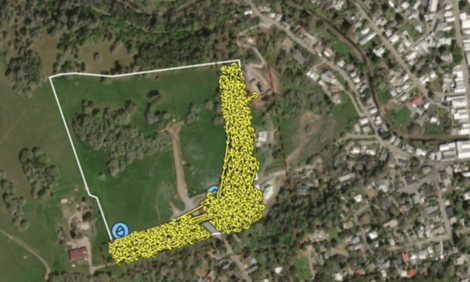



Study identifies genes potentially associated with heat- and drought-resistant cattle
Cattle productivity in Brazil is significantly affected by the decline in pasture quality during the dry period of the year. In conjunction with the effects of global warming occurring in this century, this problem makes the selection of livestock resistant to climate change increasingly necessary.
In an article published in the journal Genetics Selection Evolution, researchers in Brazil and Australia point to a solution.
The scientists identified 16 genes potentially associated with resistance to climate variations that affect weight gain in Nellore cattle, Brazil’s main beef production breed. The candidate genes are linked to cellular regeneration and differentiation and to inflammatory and immune responses, among other biological processes.
The study was part of the Thematic Project “Genetic aspects of meat production quality, efficiency and sustainability in Nellore cattle”; the principal investigator was Lucia Galvão de Albuquerque, Full Professor at the São Paulo State University’s School of Agrarian and Veterinary Sciences (FCAV-UNESP) in Jaboticabal, Brazil.
The study was conducted in partnership with researchers from the University of Queensland in Australia.
“We studied the interaction between genotype and environment in Nellore cattle, with the specific aim of identifying animals that are less sensitive to environmental changes. Breeders and scientists are always concerned with improving average productivity, but now it’s necessary to identify animals that are more resistant to climate change,” said Roberto Carvalheiro, a researcher at FCAV-UNESP and first author of the study. Carvalheiro performed part of the study in Queensland thanks to support from FAPESP via a Research Fellowship Abroad.
“This should be of particular concern in Brazil, where cattle are raised on different types of pasture and under diverse environmental conditions, especially when considering global climate change,” he added.
Database
To identify the 16 genes that may indicate tolerance to environmental variations, the researchers used the sire directory Aliança Nelore. Maintained by GenSys Consultores, based in Porto Alegre, Brazil, the directory comprises genetic and phenotypic data on productive traits that have been evaluated in more than a million calves belonging to approximately 500 Brazilian, Paraguayan and Bolivian herds.
To standardize the analysis, the researchers considered only calves that had known sires and dams; belonged to contemporary groups of at least 20 animals of the same sex; were born in the same herd, year and season; and were raised in the same management group. Their overall postweaning weight gain ranged from 30 kg to 250 kg (between weaning, at approximately seven months, and long-yearling age, approximately 17 months). Overall, the study analyzed 421,585 animals from 9,934 contemporary groups.
This dataset was considered suitable for an assessment of the sensitivity of beef cattle performance to environmental variation given the quantity of data and the diversity of herd management and environmental conditions. For example, the average annual precipitation on the cattle farms ranged from approximately 700 mm to 3,000 mm depending on the location; the dry season in some regions can last up to seven months.
Studies of this kind that focus on the interactions between genotypes and environmental conditions typically use an index that combines temperature and humidity to summarize the environmental conditions in which the animal was raised, but for researchers, this fails to capture the quality of the pasture, which is a key factor in beef cattle productivity in the Brazilian pasture-based system.
“Calves are born nine and a half months after insemination and produce only when they’re two or three years old,” Carvalheiro said. “We can forecast rainfall two weeks ahead, but we haven’t the faintest idea what the pasture on this or that farm will be like two years from now. Hence the interest in identifying animals whose performance won’t be affected by unexpected conditions.”
Weight gain ten months after weaning was chosen as a key trait affected by environmental variation and accurately recorded in the database. Calves are normally weaned as soon as the time of abundance for pastures begins to cease. Thus, the 10 month period corresponds to the advent of the dry season, causing a drop in pasture quality.
After testing several statistical models, the researchers found nonlinear reaction norm models (RNM) most suitable to analyze sensitivity to environmental variation, as genomic regions and environmental conditions are not linearly correlated. They classified such conditions as harsh (poor pasture), average (better but still poor) or good (well-managed pasture, a rarity in Brazil).
“Genes that indicate good resistance to harsh or average conditions aren’t the same as those that count most in the average-to-good gradient,” Carvalheiro said.
Results
The statistical analysis showed that under harsh environmental conditions, genes associated with acute inflammatory responses, cell differentiation and the proliferation of keratinocytes – cells that produce keratin, the key structural material in hair, horns and hooves – seemed to play an important role in beef cattle sensitivity.
In humans and mice, for example, the gene REG3A is associated with skin injury repair and skin homeostasis, thus contributing to immune defense. Another gene in the same family, REG3G, is associated with antimicrobial defense in the mammalian intestine and with intestinal mechanisms for maintaining symbiotic host-microbe relationships, potentially protecting the intestine during severe feed restriction.
On the other hand, the genes that play a key role in resistance in less harsh environments (average to good) are associated with inflammatory and immune responses. Among these, IL4 and IL13 were found to be the most plausible candidates in this type of environment. Both genes share a range of activities involving monocytes, epithelial cells and B cells, thus contributing significantly to the defense of the organism. In other studies, they have been found to be involved in regulating protein metabolism and muscle function, among other metabolic functions. Overall, the 16 candidate genes were found to be involved in 104 different biological processes.
The results of the research can be applied immediately in herds covered by the database. Bulls that perform best under harsh environmental conditions, for example, can be selected as sires and will probably have offspring that are more resistant to climate change.
However, the results must now be validated in other cattle herds. New studies will verify whether the 16 candidate genes also affect resistance to climate change in independent populations of animals not included in this study and in other breeds besides Nellore.
The article “Unraveling genetic sensitivity of beef cattle to environmental variation under tropical conditions” by Roberto Carvalheiro, Roy Costilla, Haroldo H. R. Neves, Lucia G. Albuquerque, Stephen Moore and Ben J. Hayes can be read at: gsejournal.biomedcentral.com/articles/10.1186/s12711-019-0470
This text was originally published by FAPESP Agency according to Creative Commons license CC-BY-NC-ND. Read the original here.


